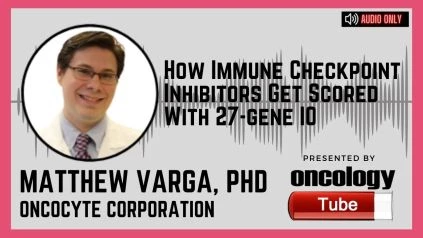Audio: Thanks, Stephanie, I appreciate the invitation to interview with you today so I’m going to talk about how the  DetermaIO algorithm and qPCR assay are used to…Read Full Transcript Here
Matthew Varga, Ph.D., a multidisciplinary scientist with broad experience in cancer biology, infectious diseases, immunology, molecular biology, and epidemiology, Scientific Affairs at Oncocyte Corporation. In this interview, he speaks about the ASCO 2022 Abstract – The 27-gene IO score is associated with molecular features and response to immune checkpoint inhibitors (ICI) in patients with gastric cancer.
Origins:
Gastric cancer (GC) is the world’s third greatest cause of cancer-related death. Unfortunately, most individuals with stomach cancer are asymptomatic until the cancer has spread to an advanced stage. In a number of malignancies, including GC, ICIs have improved patient outcomes. A number of biomarkers, including high PD-L1 expression, MSI, Epstein Barr virus (EBV) positivity, and TMB, have been used to identify patients who are most likely to benefit from ICI therapy. Despite these possible biomarkers, most advanced GC patients do not react to ICI treatment. As a result, there is still a clinical need for a biomarker that can better predict response to ICI therapy. We show that in a clinical cohort, the 27 gene IO score, a tumor immune microenvironment (TIME) classifier, is related with existing genetic markers of gastric cancer and with objective response to ICI therapy.
Methodology:
RNA-seq expression data from three distinct cohorts were obtained: TCGA (STAD), ACRG (GSE84437, GSE84426), and a clinical cohort including ICI response data (PRJEB25780, PRJEB40416). To generate IO scores, the 27 gene IO algorithm was applied to all available patient data. In each cohort, Fisher’s exact test was performed to assess the relationships between IO score and clinical characteristics and molecular subtypes. R (version 4.1.2) was used to compute ORs with 95% confidence intervals as well as ordinal logistic regression modeling.
Outcomes:
The IO score was linked with the molecular characteristics of EBV, MSI, TMB, and PD-L1 in the TCGA cohort (n = 135, p 0.05 for all). Similarly, the IO score was substantially linked with EBV, MSI, and PD-L1 in the ACRG cohorts (n = 294, p 0.001 for all). We evaluated a cohort of Korean patients with advanced stage GC compiled by Kim et al. to see if the IO score was associated with responsiveness to ICIs. The IO score was related with ICI response in this sample of 59 patients (Fisher’s exact test, p 0.05). The odds ratio for the connection between IO score and response was 5.3 (95 percent CI: 1.3 to 23.92, p = 0.01). The linearity of the IO score’s continuous value indicated a direct association between the IO score and enhanced objective response (ordinal logistic regression, t = 2.59, p 0.01).
Observations:
Because PD-L1 and TMB have demonstrated significant levels of geographical and temporal heterogeneity in GCs, there is a need for a more comprehensive biomarker that can thoroughly measure the TIME. The 27 gene IO score has been linked to numerous existing biomarkers in GC and has recently been linked to ICI responsiveness. As a result, additional research is needed to show that the 27 gene IO score is a more comprehensive biomarker for measuring TIME and provides supplementary data to tumor-specific biomarkers, which could aid in clinical decision making for ICI treatment of GCs.

